Dedicated to Health

People are our #1 priority.
Please share our website on social media and by email because our free online first aid and CPR courses save lives.

Everyone tries to avoid accidents, but being
careful and planning ahead only help so
much. After you prepare a First Aid
kit, you must have the skills, tools, and know-how
to help yourself or someone else. This part of our online certification course will help
you understand what to do in the most commonly faced situations. At the
end of this section, you will take a quiz that will summarize and highlight what you
have learned.
In order to be effective, every First Aid kit should always contain the following things:
Bite Wound
Did you know that a human bite is generally more dangerous than an animal bite? This is because human saliva can contain many more types of bacteria that cause infection. However, when a person is bitten by a wild animal (e.g. a squirrel, beaver, armadillo, raccoon, etc.) the victim will need a (current) rabies shot. These shots usually last many years before another one is needed.
Bites from domesticated pets and animals can be very painful. However, they generally do not require a trip to the hospital. Unless there is serious bodily injury, the following procedure should be implemented.
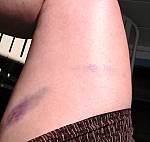
Bruise
Bruises on the skin occur when there is a contusion caused by escaping blood. This blood comes from the vessels near the surface of the skin and usually looks like a purple or greenish spot. Older people tend to bruise more than adults and children because our blood vessels become more fragile as we age. Therefore, if a child has a lot of bruising, it may indicate a more serious injury and should be taken more seriously.
When someone suffers a bruise on their head, they should be examined for head trauma. Have the victim apply an ice pack, a bag of ice cubes, or even a bag of frozen vegetables to the area for 30 to 45 minutes. Depending on how bad the injury is, this procedure should be repeated several times a day for a few days until the swelling goes down.

Burns
Burn victims require different forms of treatment based on how bad their burns are. Burns are divided into three categories: 1st degree, 2nd degree, and 3rd degree. Here are these three types of burns and instructions on how to care for them.
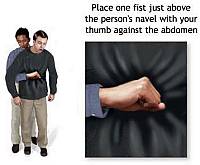
Choking
When a foreign object becomes stuck in a person's windpipe, they will choke. Choking victims often panic because they realize they cannot breathe very well, so try to keep the victim calm. Carefully assess the situation.
Even when it's obvious, it's always wise to ask someone if they are choking. If they are choking, they will probably not be able to respond. If they gasp for air, point at their throat or start to turn blue, you can conclude they are choking and will need you to perform the Heimlich Maneuver.
5. Call 911 if the victim cannot breathe after you perform this technique several times. Follow their instructions and be prepared to continue performing the Heimlich Maneuver until they arrive.

Cuts and Scrapes
Water may induce bleeding by thinning the blood. If while rinsing the wound you notice increased blood flow, use gauze or a clean cloth to apply gentle, continuous pressure until the blood clots.
Although hydrogen peroxide is commonly used as a disinfectant for minor cuts and scrapes, it is actually not very effective and may even delay the healing process by irritating a person's living cells. You can use hydrogen peroxide, but apply it around the open wound not directly to it. An antibiotic ointment such as Neosporin is a better alternative - it will keep the wound from getting infected and speed up the healing process.
Dress the wound with a bandage or sterile gauze to keep dirt and bacteria out. Change the dressing frequently and rinse the wound as often as necessary to keep it free of dirt.
Continue to monitor the wound for several days. If the injured area turns red or puffy, or if excessive pain persists, then it may've become infected and will require a physician's attention. Do not simply dismiss cuts as minor injuries as some may be quite serious if not tended to by a professional. If the wound is very deep or the bleeding is profuse, it may require stitches in order to heal properly.

Electrocution
As electricity tries to reach the ground, many different materials will allow the electricity to flow through it as a conductor. Electrocution, on a small level, can be a common household hazard because humans actually make great conductors! In most cases, medical attention is not necessary. However, it's important to be careful and take precautions, so serious electrocution doesn't alter the body's electrical impulses that guide the heart, brain, and other bodily processes.
One of the effects of exposure to harmful electricity for a period of time is burns to the skin and underlying tissues. When you approach an electrocution victim, be very cautious and assess the situation carefully. If the victim is still in contact with the electrical source, he will be a conduit and could easily expose you to the electrical current.
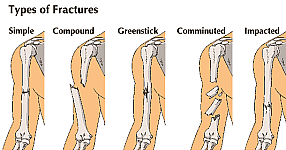
Fractures
Fractures are broken bones and may not always be obvious. Compound fractures are much more obvious because the bone breaks the skin. Consequently, it's important to correctly ascertain whether there is a bruise, a sprain, or a fracture. Here are some symptoms of fractures.
Call 911 right away and use a splint to keep the broken bone stable. If you don't have a store-bought splint, you can use a variety of materials (e.g. plastic, wood, etc.) to make one. Just make sure the splint is longer than the broken bone. Wrap the splint to the broken bone with cloth or gauze, but avoid wrapping it too tightly or it could hinder blood from flowing. Some people have even used a newspaper or magazine wrapped in cloth or gauze to stabilize a forearm fracture. However, a fracture in the victim's lower leg will require two splints - one splint on each side of the wound. If you're unable to find material for a splint, as a last resort, you could use the victim's other leg as a splint.
Ask the victim to avoid moving until help arrives. You can also utilize the ICE acronym. ICE stands for:
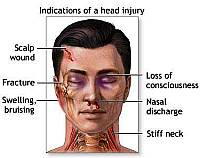
Head Injury
In most cases, head injuries are minor when they're caused by falling or being struck in the head. These injuries may result in bruising or a bump, but they're generally not dangerous. However, it's very important to examine the victim and determine whether or not he is:
When you determine a victim is suffering from a serious head injury because he displays some of the symptoms above, he will need medical attention. Call 911 immediately. Do the following until help arrives.
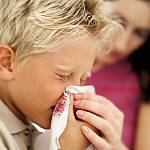
Nosebleed
Our noses have many small blood vessels in them that can be damaged easily. Nosebleeds can have a variety of causes such as being hit in the nose, falling on your nose, or even breathing very dry air. When your nosebleed is not a symptom of a serious injury, it probably won't be dangerous and probably will be easy to stop by applying pressure.
When a nosebleed isn't a symptom of a serious injury, it's almost never dangerous. Applying pressure will usually stop the nosebleed and it will rarely be dangerous or cause to see a doctor. Consider the following guidelines when approaching nosebleeds.
Call 911 or take the victim to the emergency room if their nose continues to bleed, if the blood flow is excessive or if they feel weak or faint. These are signs that there may be a more serious problem that needs to be examined and treated.
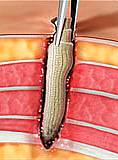
Puncture Wounds
Puncture wounds can be painful and need to be treated, even if they don't bleed a lot. If they are not attended to, the victim may suffer and infection and even more serious problems. Please don't take puncture wounds lightly.Bleeding can be heavy from bite wounds that puncture the victim's skin, so they should be taken seriously. It is important that the victim clean his or her injury with anti-bacterial soap and water, then visit a doctor as soon as possible.
A tetanus shot may be necessary if the victim suffers a puncture wound from stepping on glass or nails. Plus, these sorts of injuries may become infected easily. If the victim cannot remember when he or she got a tetanus shot, it may be wise to get another one and play it safe.
While the above puncture wounds can require special care, most puncture wounds are minor and should simply be cleaned with soap and water. Use an antibiotic ointment the speed healing and reduce the chance of infection. These sorts of wounds should be dressed with a sterile bandage and the bandage should be changed frequently.
Puncture wounds need to be examined
frequently, so the victim can avoid infection. If the wound becomes red or
puffy, he or she should see a doctor immediately because it is likely
infected. Plus, a foreign object may even be stuck under the victim's skin.
Quiz
The following statements are either True or
False. Please write your answers on a piece of paper, so you can check
them against the answers on the next page. 1. Being bitten by an undomesticated animal never
requires a tetanus shot. 9. Before you perform the Heimlich Maneuver on a
choking victim, you should always ask if he wants assistance or
not. 11. The best way to prevent infection is to use
Hydrogen sulfate. 13. Electrocution is often dangerous and/or life
threatening. 15. When a victim sustains a serious injury to his
head, it will require immediate, medical attention. 17. A nosebleed
is always a symptom of a serious head injury. 18. A nosebleed cannot
be stopped without medical attention from a doctor. 19. A puncture wound usually bleeds very
little.
2. Infections can come from minor
bites.
3. Fractured bones should be treated by a doctor
right away.
4. Broken bones are always compound
fractures.
5. Children and adults bruise quicker and
easier than older people.
6. When the victim has a head
bruise, you should check his head for trauma.
7.
A 1st degree burn is the least serious classification.
8. A
3rd degree burn never requires immediate, medical attention.
10. If the Heimlich Maneuver doesn't help, keep
performing it and don't worry about calling 911.
12. Scrapes and cuts don't
need to be cleaned with soap and water.
14.
Dry plastic, glass, and wood are good conductors.
16. CPR should be performed
on a head injury victim who loses consciousness.
20.
Puncture wounds sustained from animal bites are never very dangerous.
Click here to see how you did and get your certification card!

People are our #1 priority.
Please share our website on social media and by email because our free online first aid and CPR courses save lives.
Price Drop! Now starting at just $19.99.
We provide these products and services:

Thousands of people worldwide have learned first aid and CPR on our website.
If you need certification for work or want to help others, you're in the right place.